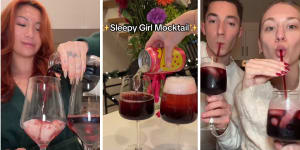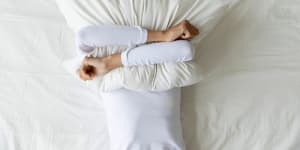Its colour is a seductive ruby-red. It fizzes gently like the frothy lip of the sea on the shore. Take a sip and this elixir will usher you to the realm of dreams and keep you asleep until dawn.
So goes the promise of the Sleepy Girl Mocktail. The viral concoction of tart cherry juice,magnesium and bubbling seltzer or soda water has thousands of sleep-starved TikTokers swearing by its soporific power.

Videos of TikTokers brewing the Sleepy Girl Mocktail have racked up millions of views.TikTok
Tart cherries contain melatonin,a common – if – hormone commonly used as a sleep supplement. One found cherry juice modestly reduced the amount of time insomnia patients stayed awake. A found the juice increased sleep time by 84 minutes.
But these studies,frequently cited in the media,were conducted over a fortnight and had only 15 and eight participants,respectively. If you can fit your sample size in a demountable classroom,you probably shouldn’t give much credence to the study results.
As for magnesium,a few small studies have shown it has a modest sleep-boosting effect. But meta analyses have identified and within these studies.
So what’s with the Sleepy Girl Mocktail hype?
“Everything works for about a week,right?” says Dr Alexander Sweetman,who studies insomnia treatments at Flinders University. “It’s this really strong placebo effect – people expect their sleep will improve with this cherry juice,or mouth taping,or holding one eye open and one eye closed. And then,because the psychological and behavioral factors are still there and haven’t been targeted and treated,long-term insomnia almost always returns.”
Click to reload

Three million Australian adults have long-term insomnia and the majority of us at least three nights a week. Sleep is fundamental to health,so if cherry juice can’t help us,what actually works?
Give me a C! B! T! I!
The best way to treat long-term insomnia is to address those psychological and behavioral factors underpinning your lack of sleep,Sweetman says.
“It’s like an iceberg. The poor sleep and daytime symptoms are the top of the iceberg,above the ocean. And when we try to treat those with sleeping pills,for example,it’s like pushing down on the iceberg temporarily.
“All of the psychological and behavioral factors are what’s causing the iceberg to bob back up to the surface … Eventually,all of those underlying factors will cause the insomnia to re-emerge.”
Treating those factors takes cognitive behavioural therapy for insomnia,or CBT-I. A published in the US National Library of Medicine found overwhelming evidence that in-person CBT-I is as effective as sleeping pills in the short-term,and is a more effective treatment for insomnia in the long-term (longer than three months).
CBT-I aims to improve how people sleep and how they function during the day by reprogramming how insomniacs think about sleep and behave around bed.

About one in five of us are in a chronic struggle with sleep.iStock
Take “conditioned insomnia” as an example. The more we undertake wakeful activities in bed,such as surfing TikTok,eating,talking,thinking,worrying,the more our brains and bodies start to learn that the bed or bedroom environment is a place for feeling awake and alert.
“Thankfully those are learned relationships,which means they can also be unlearned. And that’s exactly what CBT is,” says Sweetman.
“It identifies those different patterns and relationships,and then through a really structured series of therapies,starts to chip away at them and re-associate the bed with a state of rest,relaxation and sleep,rather than a state of alertness and arousal.”
So CBT-I works – but are there parts we should ditch?
There are many components to CBT-I,the main five being sleep hygiene,sleep restriction,stimulus control,cognitive therapy and relaxation strategies.
But in a,specialist sleep physician Dr David Cunnington found that the most hyped element of the therapy was probably the weakest treatment:sleep hygiene.
This component involves educating patients on sleep biology and encouraging lifestyle tweaks such as avoiding food,nicotine and alcohol in the hours before bed and adjusting your bedroom to be tidy,dark and cool.
“Sleep hygiene,we think,is the least effective,” Cunnington says. “But interestingly,it’s the most widely propagated and disseminated information. Because it’s easy to do,right? There are blog posts,listicles,‘Here are five ways to sleep better tonight’.
“But it’s never really been shown to be particularly effective.”
A more recent meta-analysis,,also found relaxation techniques may be “counterproductive” to overcoming insomnia. These include deep breathing exercises and progressive muscle relaxation,where you tense and relax each muscle from the toes to the tip of your nose.
Components of cognitive behavioral therapy for insomnia (CBT-I)
“It’s a really neat study,” Sweetman says of the analysis. “I guess it gets to the point that there are different components of CBT-I that might be appropriate for different patients. I wouldn’t rule out relaxation therapies entirely.
“We recommend the muscle relaxation one,but pretty importantly,I think that should be done when out of bed. Get the body into a state of rest and relaxation before getting into bed,rather than trying to use[the technique] throughout the middle of the night.”
Cunnington,who wasn’t involved in the recent meta-analysis,says many experiments on relaxation techniques were short term. The data might be capturing people attempting the techniques and getting frustrated in the first few weeks,whereas they might see long-term improvement a month or two in.
Which elements work best?
An effective component of CBT-I is sleep restriction,whereby time in bed is restricted to your average sleep duration plus 30 minutes. This limits the amount of time you’re in bed doing anything other than dozing.
Another effective mechanism is stimulus control,where patients wake up at the same time,avoid naps and only hit the sack when sleepy.
Last week’s meta-analysis identified in-person cognitive therapy as the most powerful treatment for insomnia. But researchers,including Sweetman,are working on digital CBT-I programs people can try instead of finding a sleep psychologist,which Cunnington says can be “rarer than hen’s teeth”.
An initial trial of a digital CBT-I program run by Sweetman found 75 per cent of the 60 participants had a clinically significant improvement in insomnia symptoms. A larger study of 500 people is under way. (You can find out more about the digital program and).
And,although sceptical of the Sleepy Girl Mocktail’s efficacy,it has inspired Sweetman to consider rebranding CBT-I.
“I love the name,I can tell why it’s catching on. If we could call cognitive behavioural therapy for insomnia something more exciting and sexy like that,I reckon we’d have better implementation.”
The Examine newsletter explains and analyses science with a rigorous focus on the evidence..